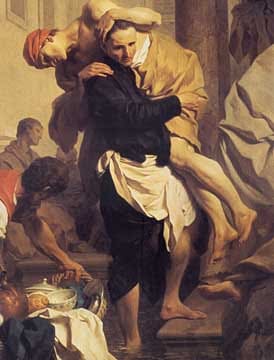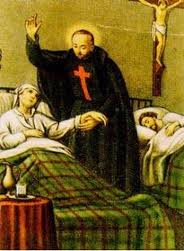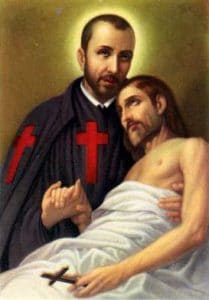A creature bled out at their feet, blood disappearing into the cracks of the uneven cobblestone. Formerly a creature of light, his light had certainly dimmed, but it was unfair to call him a creature fully of darkness. Instead, he had been confused, driven to madness in his desire to parlay with a sinister and powerful foe.
The worse tragedy was that those under his care were also deformed and twisted in an effort to please the same dark lord. But where many saw these underlings as grotesque and complicit accomplices, the cleric Arken saw them as the least among them and it filled his heart with compassion.
Arken saw them as hungry and gave them something to eat. He saw that they were thirsty and gave them drink. He saw that their clothes were in tatters, so he clothed them. Where others saw them as sick and estranged, Arken saw them as brothers and sisters, fully worthy of his care.
He knew that his deity wouldn’t want them to live in eternal punishment, simply for being under the sway of their twisted caretaker. No, Arken would become their new caretaker, and he wouldn’t be so swayed by the darkness; he would again shine a light.
How a Curse of Strahd adventure took an unexpected turn.
Arken was a player character in our D&D 5e Curse of Strahd campaign (played by Jason), but in an unusual turn of events, Jason removed Arken from the primary storyline and turned him into a NPC. Arken began as a martial class, believing his hands best used for fighting. But as the story progressed, he heard a call on his life from the gods and took a level of cleric.
When our group encountered an abbey, we came upon some unexpected things. First, the abbey was filled with half-humanoid, half-animal construct “mongrel folk” like something out of the Island of Doctor Moreau. Second, the Abbot was what in common parlance could be referred to as a “fallen angel.”

As is the way with D&D, we killed the Abbot. But then we were left with a dilemma. What would become of the poor mongrel-folk who were under his care?
If we look closely at the games we play, we can see echoes of the real world around us. There are lessons to be learned, should we be wise enough to take notice. This takes us to the story of Camillus de Lellis, an Italian who lived hundreds of years ago.
Camillus de Lellis was born in Naples on May 25, 1550. Camilla Compelli de Laureto was nearly fifty when she gave birth to him and his father was an officer in the French royal army who was seldom home. But Camillus inherited his father’s temper and his mother died in 1562. As a consequence he grew up emo and neglected, ultimately joining his father in a war against the Turks.
After a number of years of military service, Camillus found himself plagued by a leg wound that forced him to work as a laborer for some Italian friars. But despite his aggressive, sinful habits, the guardian of the abbot saw a better side to Camillus.
Eventually the friar’s kind and consistent guidance penetrated Camillus’ heart and he had a religious conversion in 1575, becoming a friar himself. After years of leveling as a fighter, Camillus took his first level as a cleric.
Still plagued by his wounded leg, Camillus felt called to a Roman hospital that cared for incurable cases. At first he was a humble caregiver at the hospital, only to later rise to the rank of director. In the meantime, he took as his spiritual director and confessor the popular local priest, Philip Neri.

Camillus was heartbroken at the poor attention the sick received from the staff of the hospital, so he encouraged a group of pious men to express their faith through the care of the patients at the hospital. He eventually felt called to establish a religious community for this purpose and Neri, his confessor, gave him approval for this endeavor, while a wealthy donor provided him with the income necessary to undertake his seminary studies.
Thus Camillus established the Order of Clerks Regular, Ministers of the Infirm (abbreviated as M.I.), better known as the Camillians. His experience in wars led him to establish a group of healthcare workers who would assist soldiers on the battlefield. Once such event saw the Camillians helping with the wounded during the Battle of Canizza in 1601 and the tent where they had all of their equipment and supplies was completely destroyed and burned to the ground.
On another occasion, Camillians devoted themselves to victims of the Bubonic plague. It was due to the efforts of the brothers and supernatural healings by Camillus that the people of Rome credited him with ridding the city of the great plague and the subsequent famine.
His concern for the proper treatment of the sick extended to the end of their lives, and to his. In fact, the Order he established continues to this very day. It has come to be known as The Red Cross. The large, red cross remains the symbol of charity and service to this day, after it was the sole artifact that survived the burned tent, an event was taken by the Camillans to signify divine approval of the Red Cross of St. Camillus.

Lessons learned? History is cool. There are fascinating stories all around us. We should fill our minds with the good ones, then allow them echo in your roleplaying games.
Always look for the helpers. Mr. Rogers reminded us that we should always look for the helpers. Yes, there are those who exploit, but there are many more out there who aim toward compassion and kindness. Let’s remember those folks and also remember that it isn’t too late to become one of those who serve the side of angels.
Let your games go in unexpected places. Jason was brilliant in letting Arken take on the role of the NPC caretaker at the abbot. Instead of being possessive of his character, he let him travel on a path that really benefitted the story.
So mad props to Arken, caretaker of the weak and the infirm. And mad props to Camillus, the saint who led the way and is immortalized in the symbol of the Red Cross, a beacon of hope and compassion that endures to this day.

